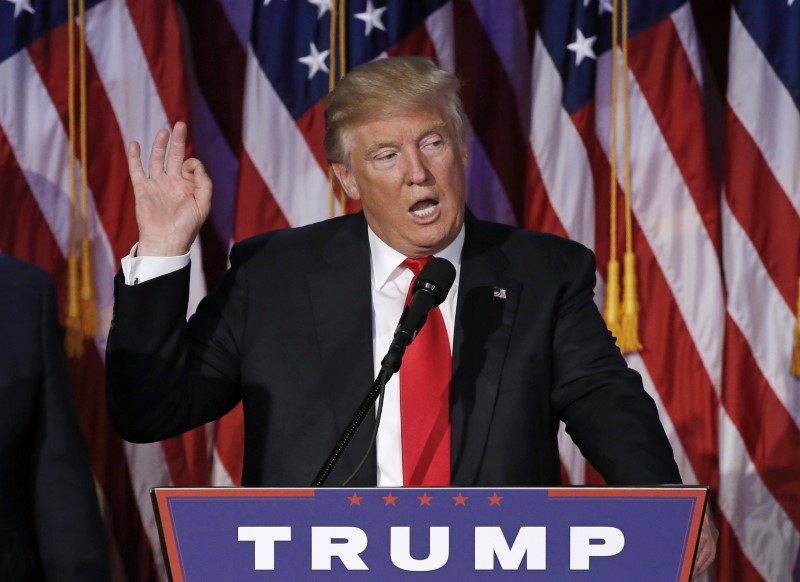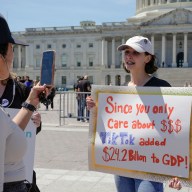By Lynn Adler and Leela Parker Deo
NEW YORK (Reuters) – US leveraged loan investors are waiting to see whether President-elect Donald Trump will follow through on campaign pledges for sweeping policy changes before significantly changing their strategies or portfolios. Investors are still working through the implications of Trump’s surprise election and are bracing for much more unpredictable markets for higher-risk assets, including lower-rated and second-lien loans. “When I look at the market over the next six to 12 months, until we truly understand what this means, I think there will be more dramatic swings and more volatility and that’s what we have to position for,” said Lauren Basmadjian, portfolio manager at Octagon Credit Investors. Intense underlying demand for loans is likely to remain as potential interest rate rises boost the appeal of floating-rate loans. Trump’s new policies could also spur higher inflation as he borrows to finance infrastructure spending. In the vacuum before the inauguration in January, investors are favoring overweight positions in sectors including healthcare and commodities where Trump has said restrictive regulations could be relaxed, while cutting exposure to autos and technology that rely heavily on international trade. Rather than alter holdings significantly, the market is currently digesting the stunning victory and trying to decipher how the many significant policy changes Trump has proposed will pan out.
Bigger strategic moves are unlikely until it becomes clearer how Trump will act on his vows to replace the Affordable Care Act, cut taxes, eliminate the 2010 Dodd-Frank Financial Reform Act and change international trade agreements. One way of dealing with the uncertainty is buying higher-risk assets on dips and selling them on rallies, Basmadjian said.
“When there’s volatility, usually you see what are perceived as risk assets, the drivers of excess returns, trade more dramatically: (debt rated) B3, Triple-C, unloved sectors, second liens are perceived to be riskier assets.” PERFORMING WELL
Leveraged loans are expected to turn in their best performance in four years in 2016. Total returns for leveraged loans are 8.43% so far this year, compared with -0.69% in 2015, according to the S&P/LSTA Leveraged Loan Index. Higher volatility and uncertainty stemming from the US elections, the Federal Reserve’s policy on interest rates and the UK’s vote to exit the EU kept a lid on loan volume this year. Completed US leveraged loan deals of US$651bn are 6.5% lower than the same time last year, according to Thomson Reuters LPC data. Trump’s plans could further exacerbate this supply-demand imbalance as investors try to buy floating-rate loans to hedge against higher interest rates and rising inflation and focus on sectors that may benefit under the new administration. “Unless our companies are in industries where there could be significant regulatory changes, we haven’t really changed our stance,” said Sean Coleman, chief credit officer at FS Investments, which focuses on middle market companies. Sectors that could fare better under the Republicans include coal, oil and gas drilling, mining and pharmaceuticals, which were in the bull’s-eye of the Obama administration and the anticipated Clinton presidency, he said. Low visibility on many business areas remains a concern. “We are not like venture capital where we are trying to hit a home run, we’re just trying to get our money back,” Coleman said. ”As a result we are generally trying to avoid sectors that could have significant regulatory downside – like a healthcare company with a lot of government reimbursement risk.” While new buyouts for robust companies backed by strong private equity firms will continue to sell, aggressive deal structures will attract more scrutiny along with marginal credits and opportunistic deals including loans to finance dividend payments. “If things become more dislocated or more volatility ripples into the credit market, second lien could be one of the first dominos to fall. People will back away,” Coleman said.
Volatility could become a way of life. The 1,100 point swing in the Dow Jones Industrial Average immediately after the election showed the markets moving “from sheer terror at one point to sheer elation in a day,” said Craig Russ, co-director of bank loans at investment firm Eaton Vance. “The dust hasn’t settled on all of this yet,” he said.
RETAINING RISK
Potential changes to the Dodd-Frank Financial Reform Act could affect the US leveraged loan market, particularly if risk retention provisions are changed, which could boost the issuance of Collateralized Loan Obligation (CLO) funds. CLOs are the biggest buyers of leveraged loans. Despite a rise in recent months, total CLO issuance has fallen this year before the introduction of skin-in-the-game rules that require managers to hold 5% of their funds on December 24.
“The number of potential issuers of CLOs has dramatically declined because of this risk retention rule,” said Russ. “To the extent relief is there, a broader pool of managers would be able to participate and that would help the market in a meaningful way.” Although CLO-friendly measures are more likely under Trump than a Clinton presidency, this remains yet another dangling uncertainty.
“We could see some looser regulations,” said Basmadjian. “But it’s so early and we don’t have a lot of detail on what that would look like or where it is prioritized on Trump’s list.” (Reporting by Lynn Adler and Leela Parker Deo; Editing By Tessa Walsh and Michelle Sierra)
U.S. loan investors conservative pending Trump policy details

By Lynn Adler and Leela Parker Deo















